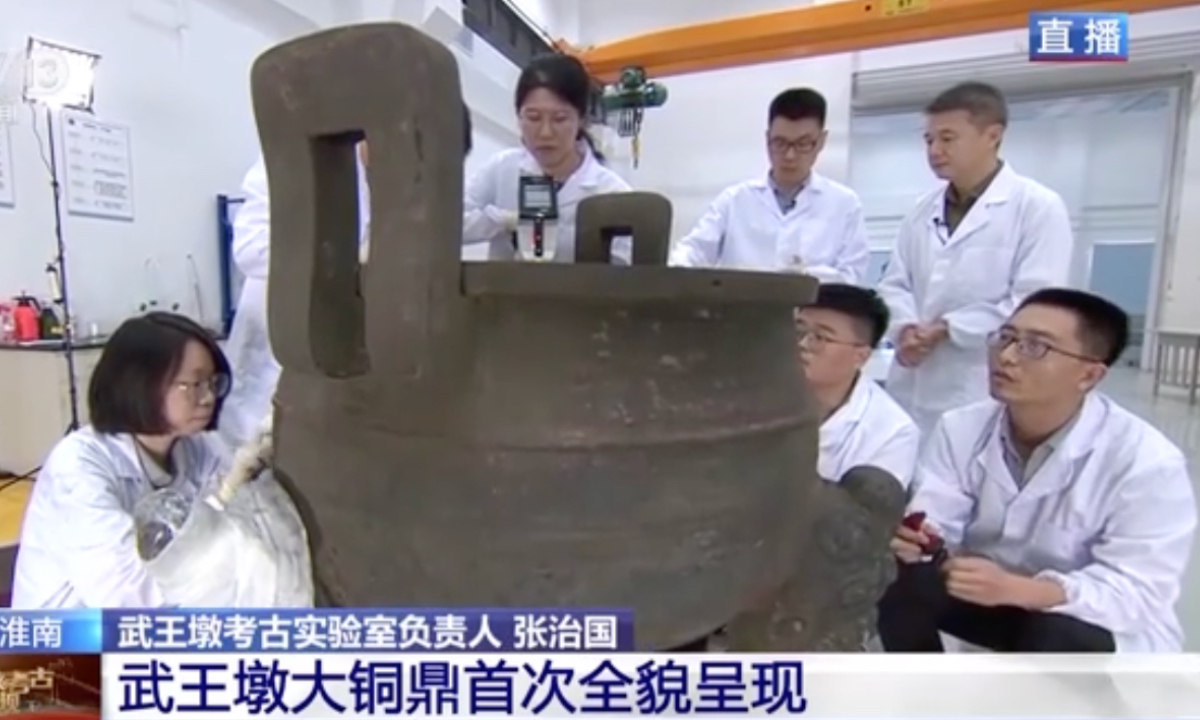
Reachers measure the ding unearthed from Wuwangdun tomb in Hunan, Was China's Anhui Province. Photo: Screenshot from CCTV
The National Cultural Heritage Administration (NCHA) announced on Saturday that the Wuwangdun tomb in Huainan, East China's Anhui Province, has been identified as belonging to King Kaolie, who ruled the ancient state of Chu from 262 BC to 238 BC. The tomb has yielded more than 3,000 artifacts, state broadcaster CCTV reported.
Earlier this year, the administration confirmed the tomb as the largest and highest-ranking tomb of the ancient Chu state, which existed more than 2,200 years ago during the Warring States Period (475 BC-221 BC).
According to the administration, the excavation of four side chambers to the north and west of the central burial chamber has been completed, while work on two additional chambers to the south and east is underway.
The artifacts unearthed in the eastern chamber are primarily bronzewares, with more than 150 items retrieved so far. Among these, a large bronze ding, a type of ancient Chinese food vessel, was unearthed on Saturday afternoon.
With a diameter ranging from 88.2 centimeters to 88.8 centimeters, an overall height of about 112 centimeters, and a handle-to-handle distance of about 111.1 centimeters, it is the largest Chu state ding discovered to date.
Both the handles and the body of the ding are adorned with intricate patterns, including stylized dragon motifs and phoenix bird designs. Further detailed identification of these surface decorations is pending additional study.
"Three ding of this type have been unearthed from this tomb. We had already retrieved two, and this remaining one is the largest, indicative of the burial customs of Chu kings," said Zhang Wenjie, head of the first archaeological team of the excavation project.
Experts confirmed that the artifacts exhibit typical characteristics of late Warring States period Chu culture, including their form, decoration and combinations. Comprehensive analyses of the tomb's scale, structure, and inscriptions, along with historical records, suggest that the tomb's occupant was likely King Kaolie.
Animal bones and plant remains were also found inside the vessel. The specific types of these animal and plant remains will require further examination and identification through zooarchaeological and archaeobotanical research once they have been thoroughly cleaned and prepared.
"This sizable ding was likely used specifically for cooking beef," Zhang said. Alongside the bronzeware, more than 100 lacquered wooden dining and daily utensils, including tables, altars, boxes and couches, were also unearthed from the additional east chamber.
Archaeologists have used infrared cameras to examine the inner coffin boards and discovered ink inscriptions in the eastern chamber, the contents of which are still being analyzed. Previous findings in several chambers revealed ink inscriptions that provide crucial information about the construction of the tomb.
Together, a total of more than 3,000 artifacts have been extracted from the south and east of the central burial chamber, along with numerous plant and animal remains.
Despite significant looting in the northern chambers, more than 600 items have been retrieved, mostly stringed musical instruments such as zithers. Archaeologists have also discovered a complete set of chime bell racks with 14 suspension holes, matching the number of bronze chime bells recovered nearby.
The southern chambers have yielded lacquer boxes, cups, plates, vessels, drums, jade disks, and bronze arrowheads. The western chambers primarily contained lacquer wooden figurines, along with wooden carts, musical instruments, and some bamboo slips inscribed with text.
The tomb had been looted multiple times throughout history. In 2019, the NCHA approved Anhui to carry out salvage archaeological excavation of the tomb. A year later, the excavation work officially started and was listed as part of a national project that aims to trace the origins of Chinese civilization through archaeological endeavors.
Spanning an area of more than 140 square kilometers, the Wuwangdun tomb complex houses a main burial chamber, chariot and horse pits, accompanying graves, and sacrificial pits. Eight additional chambers were discovered around the pit, with a central coffin chamber covered with multiple layers of planks.
Previously, the research team conducted identification of animal and plant remains, as well as residue analysis. Among the identified animal bone remains were over 10 species, including cattle, pigs, and dogs. Plant remains revealed various fruits such as gourds, melons, plums and chestnuts, as well as grains like millet, sorghum, and rice, spice crops like pepper and mallow, and traditional Chinese medicinal plants such as Evodia rutaecarpa.
Global Times